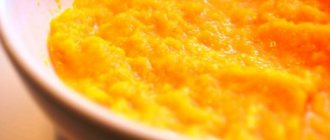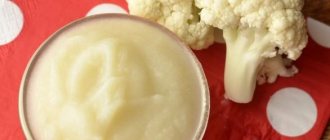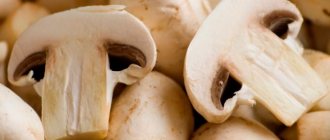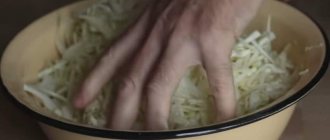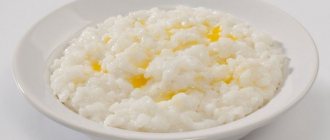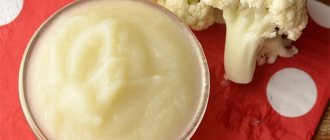Mashed potatoes
From 5 months.
You will need: 2 potatoes, 4 tablespoons of milk (breast or formula), 1 teaspoon of butter.
Wash the potatoes well. Peel it. Wash again. Steam the potatoes or bake them in the oven until soft. Rub the still hot potatoes through a sieve or grind in a blender. While whisking the potatoes, gradually pour in the hot milk. Place the resulting puree on the fire and boil for another 2-3 minutes. Remove from heat and add butter. Refrigerate.
Feeding a baby: basic rules for introducing a baby to solid food
The first feeding of a baby is an important stage in development. The nutritional needs of a newborn are fully satisfied through mother's milk or formula. But there comes a time when there is a need for additional nutritional components, vitamins and minerals. Timely introduction of solid food into the baby’s menu is a prerequisite for his full growth. Let's figure out how to properly introduce a child to new products.
Introduction dates
In most families, the introduction of complementary foods causes a lot of controversy. The older generation insists that from the age of 3 months a child can be given natural juices. Indeed, during the USSR this very approach was practiced. But modern research has proven him wrong.
Cauliflower and zucchini puree
From 6 months.
You will need: 50 g cauliflower, 60 g zucchini, 2 tablespoons of milk (breast or formula), half a teaspoon of vegetable oil.
Rinse the vegetables well with running water. Peel the cabbage. Divide it into small inflorescences. Cut the zucchini into small pieces. Place the vegetables in an enamel pan. Pour boiling water over everything so that the water completely covers the vegetables. Close the lid and cook until fully cooked. Rub the still hot vegetables with the broth through a sieve until smooth. You can use a blender. Add hot milk to the puree. Boil for another 1-2 minutes. Add vegetable oil to the finished puree and mix.
How to make puree for your baby
From the site www.znaikak.ru
Even young mothers who consider themselves experienced housewives, when faced with the need to introduce puree into their child’s diet, are at a loss. What puree and when to administer? And most importantly, how to cook it? – many young mothers face these questions.
The very first complementary food is fruit puree.
.
Fruits are sources of vitamins. You can try introducing fruit puree into your baby’s diet at 3 – 3.5 months. The introduction of purees must begin with monocomponent products (from one type of product). Fruits are introduced into the child’s diet in the following sequence: first applesauce, then pear, plum, carrot, apricot and peach. The puree should be administered with a small teaspoon, and provided that the child does not develop an allergy, the portion should be increased gradually. Next, let's look at a few simple fruit puree recipes. Apple puree
.
When preparing meals for your child, always use only fresh and ripe fruits. The apple must be washed, peeled, core and seeds removed. After this, the apple can be grated on a fine grater or chopped in a blender, which is much more convenient. In general a blender
is an indispensable assistant for a young mother; it makes making any puree for the baby much easier.
In a similar way, you can make puree from other fruits, or by combining them. Pumpkin puree with apple
.
Pumpkin and apple must be thoroughly washed, peeled and pitted. Then cut the pumpkin into pieces and cook with the lid closed. After cooking, grind the pumpkin in a blender and combine with grated apple. After fruit puree, you can try introducing vegetable puree
.
Vegetables are the basis of baby food. Vegetable puree is introduced from 4.5 to 5.5 months. It's best to start with zucchini, cauliflower and potatoes. Then you can try offering your baby a multi-component puree with carrots, white cabbage, and green peas. Next, let's look at several recipes for making vegetable puree. Zucchini puree
.
The zucchini needs to be washed, peeled and soaked in cold water for about 4 hours. Then cut it into pieces, add a small amount of water and cook with the lid closed over low heat. When all the water has almost boiled away and the zucchini becomes soft, it must be crushed in a blender until smooth. If the puree turns out thick, and the baby is already receiving vegetable puree in accordance with age (5 months - 150 g), then you can add vegetable oil - 1/4 teaspoon. To add flavor to the puree, you can add a little salt. Mashed potatoes are prepared in a similar way. Puree of various vegetables (with potatoes)
.
To prepare such a dish, you can use 2 - 3 types of vegetables. For example: zucchini, carrots and potatoes. All vegetables must be peeled and soaked in water for about 4 hours. Then cook the vegetables over low heat with the lid closed. When the vegetables are cooked, grind them in a blender until smooth. Then you can add a little milk, stir and put it back on the stove. Then whisk everything together.
You can try introducing
meat puree Meat is a source of protein. It is necessary to start introducing meat puree with one type of meat, for example, rabbit or turkey, and later you can offer beef. The first meat puree should be homogenized, and from 8 to 9 months it can be replaced with meatballs. By one year old, your child can be offered steamed cutlets. To prepare meat puree,
you need to choose meat without veins, fat or films.
Cut the meat and cook until fully cooked. Meat puree can be made by passing it through a meat grinder twice or grinding it in a blender. You can add milk to the resulting minced meat. When your baby gets used to meat puree, you can try cooking it with vegetables. In this case, you can add a little butter to the puree. Meatballs
.
Meat fillet must be minced twice. Soak a piece of white bread. Then pass the bread and meat through the meat grinder again. The resulting minced meat must be beaten, adding cold water little by little. Then we roll several balls and cook in water or steam. From 9 months, fish puree
(1 – 2 times a week).
Fish is a source of minerals. It is better to use low-fat sea fish to feed your child, as it contains more iodine and beneficial microelements. Next, let's look at some interesting fish recipes. Fish pudding
.
One small potato needs to be boiled and then mashed with a masher so that there are no lumps left. If the puree turns out thick, you can add a little milk. Next you need to clean 100 grams of sea fish and cook in salted water. Finely crush the fish pulp, mix with potatoes, adding a little melted butter and salt. Then beat half the egg with a mixer into a thick foam. Grease the mold with oil, place the fish mixture there, pour in the beaten egg, and close the lid. Cook in a water bath for 20 - 30 minutes. Steam cutlets
.
The minced meat is prepared in a similar way to minced meat for meatballs (with white bread). Then we make small cutlets and place them in a greased frying pan. Fill the pan halfway with water and cook the cutlets until tender with the lid closed. Fish bits
. Take 100 grams of sea fish and cut it into pieces, add finely chopped parsley and dill. Pass 1/8 of the onion through a meat grinder and mix with fish. Divide the resulting mass into thin cakes and soak them in beaten egg. Then put it in a frying pan. Add 2 - 3 tablespoons of water and place in the oven. When introducing a new dish into a baby’s diet, it is necessary to carefully monitor the baby’s well-being, changes in behavior, digestion and bowel movements. At the first signs of an allergy, the product should be excluded from the diet and consult a doctor. These simple recipes for purees and dishes from vegetables, fruits, meat and fish will make your baby’s diet varied and complete. And every mother can bring something of her own to any dish. Your baby will always be full and satisfied, and subsequently will easily move on to the “common table”.
Carrot and potato puree
From 7 months.
You will need: 2 potatoes, 1 carrot, 4 tablespoons of milk (breast or formula), 1 teaspoon of vegetable oil.
Read also: Parade of goodies: 5 of the most delicious children's casseroles
Wash the carrots and potatoes well. Clean and wash again. Cut the vegetables into cubes. Place them in an enamel pan. Pour boiling water so that the water covers the vegetables. Cook the vegetables over low heat, covered, until tender. Rub hot vegetables through a sieve until smooth. You can use a blender. Add milk, salt, vegetable oil to the puree. Bring to a boil, remove from heat and cool.
From mom with love
Many mothers with the best intentions prefer to prepare baby puree at home in order to provide the baby with the most natural food. This solution has both pros and cons.
Advantages
- you cannot be deceived in the naturalness of the process: after all, you do everything yourself;
- in this case, the mother is the main expert on storage conditions and compliance with expiration dates;
- baby purees prepared at home are always the freshest and healthiest;
- guaranteed absence of preservatives, dyes and other harmful additives;
- You can prepare the treat “in bulk” and store it in the freezer;
- confidence in sanitary cooking conditions;
- saving money, because it’s easier to buy the necessary products for future use rather than spending money on a jar of puree every time;
- you determine the portion yourself and, depending on it, select the right amount of ingredients;
Flaws
Making puree at home also has its disadvantages:
- the complexity of the process is familiar to every mother of a baby who has chosen homemade complementary foods;
- making puree yourself takes a long time, and this time could be spent on more enjoyable activities: for example, playing with the baby;
- the quality of purchased vegetables and fruits is often questionable, especially if you purchase them out of season;
- The shelf life of a fresh product is limited to a day in the refrigerator, and even this is undesirable;
- homemade purees are more difficult to take with you;
- It is problematic to prepare small portions: especially in a blender, when the minimum amount has to be literally scraped off the walls.
Carrot puree
From 7 months.
You will need: 1 medium carrot, hot water, 2 tablespoons of milk (breast or formula), ¼ teaspoon of butter.
Wash the carrots well, peel them, wash them again. Cut the washed carrots into cubes, place them in an enamel pan, pour boiling water so that the water covers the carrots. Steam or simmer the carrots, covered, until the carrots are cooked through and the water has evaporated. Rub the hot carrots through a sieve until smooth. You can grind carrots in a blender. Add butter, hot milk and mix everything. Boil for another 2-3 minutes. Cool before serving.
Zucchini and chicken puree
From 9 months.
You will need: 150 - 200 g of zucchini pulp, 50 g of boiled white chicken or turkey meat, ¼ glass of milk, 1 tablespoon of butter.
Wash the zucchini well. Peel it and cut into small slices. Steam until fully cooked. While hot, grind the zucchini through a sieve until smooth. Mix with chopped poultry until smooth. Pour in hot milk, add salt and boil for another 2-3 minutes. Add butter to the finished puree.
Cauliflower puree with milk
From 6 months.
You will need: 100 g of cauliflower, 2 tablespoons of milk (breast or formula), half a teaspoon of vegetable oil.
Rinse the cauliflower well. Cut it into florets. Remove green leaves. Place small cauliflower florets in an enamel pan. Pour boiling water over it so that the cabbage is completely submerged in water. Close the lid and simmer until the cabbage is cooked and the water has completely evaporated. Rub the hot cabbage through a sieve until smooth. You can use a blender. Add hot milk to the puree and boil for another 1-2 minutes. Add vegetable oil to the prepared hot puree.
steamed broccoli for babies
Broccoli puree for babies
This page contains the most popular posts and comments from our users on the topic “Broccoli puree for babies.” This will help you quickly get an answer to your question, and you can also take part in the discussion.
1. Prepare the ingredients: wash the broccoli and divide it into florets. It is better to take unrefined oil - flaxseed or olive. I've been using macadamia nut oil a lot lately. It has virtually no taste or smell, and at the same time is very valuable and beneficial for the body. 2. Place broccoli florets on a wire rack for steaming. 3. I cook broccoli in.
My son devoured this puree on both cheeks, but to be honest, the smell was terrible. Although in general I like broccoli myself, stewed or steamed, but in puree.
Pumpkin is a universal fruit. North Americans began to consciously grow and use it in cooking. Many articles have been written about the benefits of this product for humans. As a young mother, I was excited by the question: “Should I give my baby this berry and in what form?” Pumpkin puree is a storehouse of vitamins that the baby needs so much. Benefit or harm It has been scientifically proven that pumpkin contains: Vitamins A.
Mashed potatoes for infants - general principles of preparation Mashed potatoes for infants are one of the first dishes that babies try, so you need to approach its preparation with all responsibility. All purees for infants can be divided into several types: fruit and vegetable, single-component and multi-component. It is best to start complementary feeding with one-component purees, gradually introducing them into the mixture.
Apple and pumpkin puree
From 6 months.
You will need: 100 g pumpkin pulp, 1 apple, 1 teaspoon butter.
Rinse the pumpkin and apple well. Peel off the peel and remove the seeds. Cut the fruit into pieces. Pour water over the pumpkin and cook over low heat, covered, until soft. Add an apple. Cook for another 10 minutes. Grate the still hot fruits on a fine grater along with the broth until smooth. You can use a blender. Boil the puree for another 102 minutes. Cool, add butter and serve.
How to introduce first complementary foods correctly
General information
The question of how to introduce the first complementary foods to a child at a certain period is very important for every mother. There is very different information about how the baby’s first complementary foods are introduced. At the same time, information on the Internet is fundamentally different from what people of the older generation talk about.
But no matter how many recommendations a young mother receives, it is important that the baby’s first complementary foods are introduced as correctly as possible. That is why you need to familiarize yourself with those recommendations that will allow you to get answers to the most important questions. For example, at what age can you give water to a baby, at what months can you give cottage cheese, and the like.
Every mother needs to familiarize herself with this information in detail so that she can provide her baby with complementary feeding that will be introduced correctly. This, in turn, will ensure that both the breastfed baby and the bottle-fed baby will have a properly functioning digestive system.
First complementary foods during breastfeeding, general rules
Young mothers always have a lot of questions about how to properly introduce supplementary feeding, whether it is necessary to give water, etc. First of all, it is important to take into account that with full breastfeeding , that is, if the mother maintains the feeding schedule, the baby is actively growing, supplementary feeding The child does not need it before six months.
Sometimes mothers, believing that the baby is not receiving enough breast milk, begin supplementing with formula . However, most pediatricians, including Komarovsky , believe that there is no need to supplement well-developing babies. When to give additional formula and whether it should be done, it is better to ask your pediatrician.
Puree of potatoes, carrots, cabbage, beets and pumpkin
From 8 months.
You will need: 1/5 potato, 30 g each of carrots, pumpkin, beets, white cabbage, 2 tablespoons of milk (breast or mixture), half a teaspoon of vegetable oil.
Wash the vegetables thoroughly. Peel them and cut them into small pieces. Place the chopped vegetables in an enamel pan, add water, cover with a lid and simmer over low heat. Water should not be allowed to completely evaporate. When the vegetables become soft, rub them hot through a sieve until smooth. You can use a blender. Add hot milk to the puree and bring everything to a boil. Add vegetable oil.
Feeding from a jar
Often, due to lack of time or the presence of any convictions, parents of infants decide that making purees at home is not practical. Then store-bought products come to their aid.
Advantages
Puree bought in a store is often also a good option, because it has significant advantages:
- its quality is subject to strict government control;
- Manufacturers have thought through everything for convenience: sealed packaging and long shelf life;
- the main advantage for many women is that they do not have to waste time on cooking;
- the food is completely ready to eat;
- Manufacturers take into account the characteristics of the baby’s age and make the product in accordance with them;
- In many purees, several ingredients are mixed at once: for example, vegetables and cereals;
- often children's products contain additional vitamins;
- You can read the entire composition on the jar to be sure of your purchase.
Flaws
Unfortunately, store-bought purees for babies also have some disadvantages:
- the nutritional value of store-bought treats is often lower compared to home-prepared treats due to the high water content;
- the taste is sometimes less intense;
- sometimes quality control is not the strictest and you can lose sight of the freshness of the ingredients and the correctness of the cooking technology;
- the high price for one jar is also not encouraging;
- Many store-bought purees contain unwanted salt and sugar.
Vegetable puree with kohlrabi, spinach and potatoes
From 8 months.
You will need: half a head of kohlrabi, 100 g of spinach, 1/3 of a potato, the yolk of one boiled egg, 2 tablespoons of water, 1 tablespoon of butter.
Rinse the vegetables thoroughly. Grind the kohlrabi. Set some of the green kohlrabi tops aside. Peel the potatoes and rinse them again. Cut it into slices. Place the potatoes and kohlrabi in an enamel pan, add butter, cover with a lid and simmer for about 15 minutes. Chop the reserved kohlrabi and spinach and add to the stewed vegetables. Simmer for another 5 0 10 minutes. Rub hot vegetables through a sieve until smooth. You can use a blender. Add egg yolk and stir.
We carefully select ingredients
In such an important issue as the introduction of complementary feeding to a baby, it is useful for every mother to know which products are optimal for the child’s body at the age of about 6 months.
The first dish for a baby is usually vegetable purees and sometimes porridge. Today we are talking about puree. The main criteria when choosing a product for its preparation are hypoallergenicity, benefits, safety and ease of absorption by children's digestion.
Universal components for complementary feeding include zucchini and broccoli: it is from them that most parents prepare the first puree in their baby’s life. When he has mastered these simple vegetables, it will be the turn of pumpkin, potatoes, green peas, carrots, spinach and kohlrabi.
But the question arises: which puree is better, homemade or store-bought?

